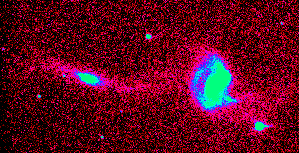At optical (red) wavelengths, the peculiar galaxy NGC 7714/5 looks like this:
 NGC 7714 is to the right (west) and NGC 7715 to the east.
The galaxies
are separated by 2 arcminutes (25 kiloparsecs).
Note the stellar bridge between the galaxies and
the tidal tails extending from both galaxies.
Also notice that NGC 7714 has a partial ring.
This image was obtained by
Beverly Smith with the 2.1m telescope
at
McDonald Observatory in collaboration with
Rick
Pogge (Ohio State University).
NGC 7714 is to the right (west) and NGC 7715 to the east.
The galaxies
are separated by 2 arcminutes (25 kiloparsecs).
Note the stellar bridge between the galaxies and
the tidal tails extending from both galaxies.
Also notice that NGC 7714 has a partial ring.
This image was obtained by
Beverly Smith with the 2.1m telescope
at
McDonald Observatory in collaboration with
Rick
Pogge (Ohio State University).
The distribution of interstellar atomic hydrogen
in this system looks like this:

These data were obtained with the
Very Large Array,
part of the
National Radio Astronomy Observatory.
This map has 12 arcsecond resolution.
The gas distribution is color-coded, with the highest
column density red and lowest blue.
The yellow contours are optical data from the
Digitalized
Palomar Observatory Sky Survey, smoothed
to 12 arcseconds
resolution.
Notice the complete loop of gas to the northwest
of NGC 7714. Also notice that
the gas in the bridge and eastern tail
is shifted to the north relative to the
stars
(From
Smith, Struck, and Pogge 1997,
Astrophysical Journal, 483, 754).
For some narrowband
optical images of this system
obtained by
Rick
Pogge,
look at the
Ohio
State
Picture Gallery.
To see a mpeg movie of a simulation of the NGC 7714 and NGC 7715 encounter,
click here (from
Smith and Wallin 1992,
Astrophysical Journal, vol. 393, p. 544).
In this model, the smaller galaxy has a mass of 1/3 that
of the larger galaxy and the impact parameter is 0.85 times
the radius of the larger disk.
Compare the
final frame with the McDonald optical image shown above.
Notice
that the ring, the bridge, and the tails are successfully reproduced.
This model only contains stars.
 NGC 7714 is to the right (west) and NGC 7715 to the east.
The galaxies
are separated by 2 arcminutes (25 kiloparsecs).
Note the stellar bridge between the galaxies and
the tidal tails extending from both galaxies.
Also notice that NGC 7714 has a partial ring.
This image was obtained by
Beverly Smith with the 2.1m telescope
at
McDonald Observatory in collaboration with
Rick
Pogge (Ohio State University).
NGC 7714 is to the right (west) and NGC 7715 to the east.
The galaxies
are separated by 2 arcminutes (25 kiloparsecs).
Note the stellar bridge between the galaxies and
the tidal tails extending from both galaxies.
Also notice that NGC 7714 has a partial ring.
This image was obtained by
Beverly Smith with the 2.1m telescope
at
McDonald Observatory in collaboration with
Rick
Pogge (Ohio State University).
